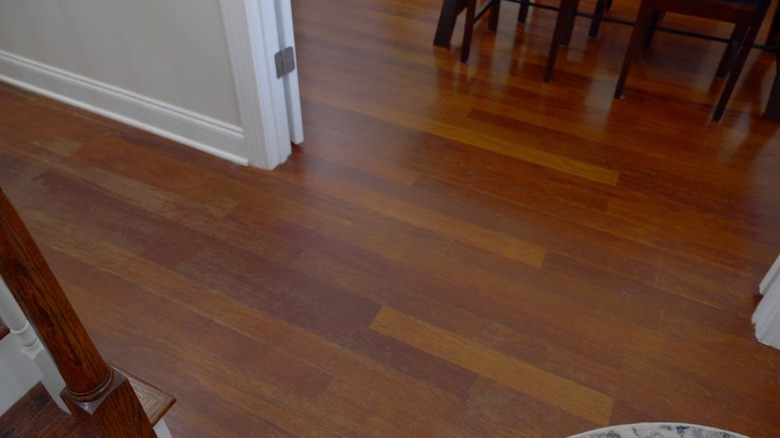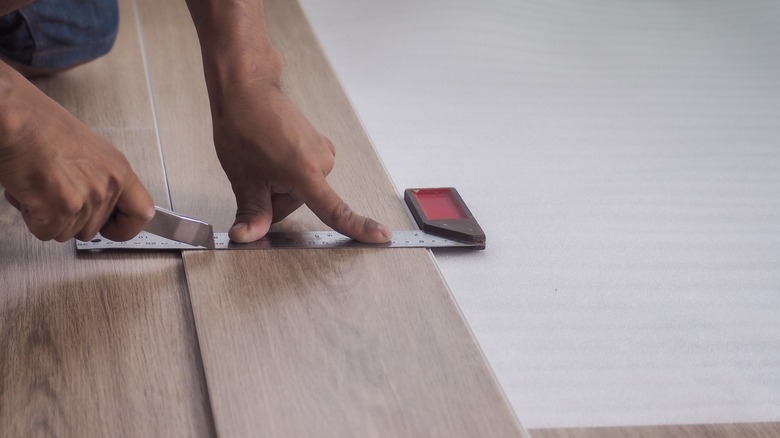HGTV's Hilary Farr Ditches Hardwood Flooring For A More Durable Alternative
For some people, hardwood flooring will always be the right choice when designing a space. It adds instant elegance, and it can mesh with all sorts of different design styles. Whether you like industrial farmhouse or mid-century modern, hardwood acts as a stylish backdrop to your room. But, just because it's coveted doesn't mean it's the right pick for your particular home. If you have an active lifestyle filled with pets and young kids, you likely want to go with something that wears a bit better.
That's exactly what HGTV's Hilary Farr believed when renovating a client's home in Season 2, Episode 7 of "Tough Love with Hilary Farr." On the show, the HGTV host swooped in to help Andy and Nichole, a couple who moved into their house a year and a half ago but have been too busy to make any design decisions. One of the first things Farr decided to change for them was the flooring.
"I look at the [hardwood] floors in this house, and they really do need replacing," Farr shared in the episode. "The thing is, they really shouldn't be hardwood again. With their dogs and their lifestyle, hardwood is not the best solution. Which works out for me, because I have an LVP that's going to look great and cost half as much." In order to keep the floors in pristine condition for years to come, the designer decided to go with a manufactured flooring option that can resist wear and tear better. For some, this might be a controversial choice, but here's a closer look into why she decided to go that route.
Why Farr traded in hardwood for LVP
When the couple showed Farr what they would like to change, the first thing they mentioned was their hardwood floors. "Previous owners had a lot of young children, and so the floors are just destroyed," the homeowner explained. There were areas where the finish was worn down to the raw wood underneath, especially in high traffic areas such as the kitchen. However, since they themselves have a 13 year old son and a dog, Farr decided it would be best to skip the hardwood and instead put in something more durable, like luxury vinyl plank flooring.
"You get all the beauty of the natural wood," Farr explained in the episode, "and you get all the durability of it not being natural wood. You can drop something on this, and it's not going to make a dent. You can spill things on it, and you can wipe it up."
It also gives you some wiggle room on the budget. In the episode, the floor representative explained that Farr could cut costs if she chose flooring that had less color and pattern variation in it. This made it look a little less like natural hardwood, especially since the grain pattern repeated. But, Farr didn't think that would ruin the aesthetic of the space, and went with that more budget-friendly option.
Why LVP is more durable than hardwood
When weighing if you should get wood floors or vinyl planks, the decision is clear, especially if you have an active household. Not only is LVP more affordable than hardwood, but it's also more durable, which is why Farr ultimately chose it. One of the biggest perks is that LVP is much more moisture-resistant while water is the natural enemy of hardwood. Anything from humidity to a water spill can be absorbed by the natural wood fibers, which will then swell and eventually warp or buckle. LVP doesn't have that issue because it has a waterproof top layer and a dense core, making it very difficult for water to seep through.
LVP is also more scratch-resistant than hardwood. Since hardwood is a natural material, you will be able to see dents and scratches on it. But, LVP has a thick wear layer, which is a clear plastic coating that goes on top and protects the printed wood grain underneath. The denser the layer, the more wear and tear it can handle since you would have to wear down the clear coating to get to the plank underneath. These layers are usually 6 to 22 mils thick, and 22 mil planks can be installed in heavy foot traffic areas to withstand showing signs of discoloration or scuffing.


